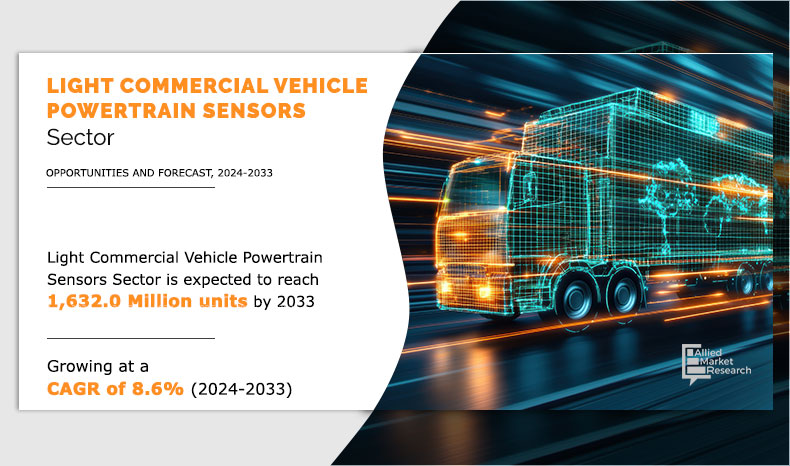Volume Insights on Light Commercial Vehicles Powertrain Sensors Sector

Volume Insights Strategic Overview
Allied Market Research announces the release of its comprehensive analysis of global shipments of light commercial vehicle (LCV) powertrain sensors. Designed to ensure optimal performance, fuel efficiency, and emissions control, powertrain sensors are essential components in modern LCVs. These sensors play a pivotal role in enhancing vehicle efficiency and diagnostics while supporting compliance with increasingly stringent global emission regulations. As the demand for vehicle electrification rises, powertrain sensors are becoming indispensable for maintaining high-performance standards and meeting evolving regulatory requirements across various LCV segments.
The report highlights the growing demand for light commercial vehicle powertrain sensors, especially pressure sensors, across key regions and countries. Temperature sensors have grown significantly, fueled by electrification and stricter emission regulations.
The steady growth is attributed to the rise in adoption of sustainable farming practices, increase in focus on soil health, and government initiatives supporting soil enhancement technologies. The global volume of light commercial vehicle powertrain sensors is expected to grow from 787.2 million units in 2023 to 1,632.0 million units by 2033, registering a CAGR of 8.6% during the forecast period.
The rapid expansion of the LCV powertrain sensors sector volume share is supported by continuous innovation in product development, particularly in oxygen sensors (O2 Sensors), mass airflow sensors, crankshaft position sensors, camshaft position sensors, and exhaust gas temperature sensors. These advancements enhance fuel efficiency, emissions control, and overall vehicle performance, aligning with stringent regulatory standards.
Regional Light Commercial Vehicles Powertrain Sensors Sector Volume Growth
Asia-Pacific dominated the light commercial vehicle powertrain sensors sector sales with 48% share in 2023 and an 8.1% CAGR, while North America, Europe, and LAMEA show strong growth at 7.1%, 7.7%, and 9.5% CAGR respectively, driven by electrification and stricter emission regulations.
The regional analysis highlights significant variations in adoption trends and sector volume growth potential across the globe. Asia-Pacific led the light commercial vehicle powertrain sensors industry, contributing 48% of the total volume in 2023, with growth driven by rapid electrification, increase in vehicle production, and stricter emission regulations. The region is expected to expand at a CAGR of 8.1% (2024-2033), with China, India, and Japan being key contributors to this growth. North America, led by the U.S. and Canada, is projected to maintain robust growth at a 7.1% CAGR, fueled by the rising adoption of electric and hybrid LCVs, along with stringent environmental regulations promoting advanced sensor technologies. Europe, with key countries such as Germany, France, and Italy, is expected to witness a 7.7% CAGR, driven by government incentives for cleaner transportation and advancements in powertrain sensor technology. Meanwhile, LAMEA (Latin America, Middle East, and Africa) offers significant growth opportunities, registering the highest CAGR of 9.5%. Countries such as Brazil and the UAE are driving this expansion due to increasing demand for fuel-efficient LCVs and improvements in vehicle electrification infrastructure.
Light Commercial Vehicles Powertrain Sensors Sector Volume Growth, By Region, 2023-2033 (Million Units)
Region | 2023 | 2028 | 2033 | CAGR (2024–2033) |
North America | 220.3 | 279.7 | 424.7 | 7.1% |
Europe | 116.5 | 152.1 | 237.7 | 7.7% |
Asia-Pacific | 379.1 | 502.7 | 798.0 | 8.1% |
LAMEA | 71.4 | 101.5 | 171.7 | 9.5% |
Total | 787.2 | 1,035.9 | 1,632.0 | 7.9% |
Source: AMR Analysis
Light Commercial Vehicles Powertrain Sensors Country Sector Sales
China and the U.S. lead the light commercial vehicle powertrain sensors industry and are projected to reach 180.4 million units and 140.3 million units by 2033 at 8.3% and 6.6% CAGR respectively, while India (9.9% CAGR) and Brazil (8.5% CAGR) are driven by increase in vehicle electrification, emission regulations, and fleet modernization efforts.
The report identifies China and the U.S. as the largest contributors to the light commercial vehicle (LCV) powertrain sensors sector volume application. China, driven by rapid advancements in vehicle electrification and stringent emission regulations, is projected to reach 180.4 million units by 2033, achieving a CAGR of 8.3%. The U.S., benefiting from fleet modernization and growth in demand for fuel-efficient LCVs, is expected to reach 140.3 million units, growing at a steady 6.6% CAGR.
Emerging regions such as India and Brazil are expected to drive significant growth due to increase in investments in electrification, emission compliance, and commercial fleet expansion. India, supported by government incentives and rise in demand for next-generation powertrain technologies, is anticipated to grow at the highest CAGR of 9.9% among major countries. Meanwhile, Brazil, leveraging its expanding commercial vehicle industry and evolving regulatory landscape, is projected to grow at a CAGR of 8.5%, reflecting its commitment to sustainable transportation solutions.
Light Commercial Vehicles Powertrain Sensors Sector Volume Share, By Country, 2023-2033 (Million Units)
Country | 2024 | 2028 | 2033 | CAGR (2024-2033) |
China | 180.39 | 241.35 | 386.5 | 8.3% |
U.S. | 140.26 | 173.98 | 257.94 | 6.6% |
India | 35.62 | 51.47 | 88.45 | 9.9% |
Canada | 21.47 | 28.92 | 46.44 | 8.4% |
Brazil | 20.93 | 28.45 | 45.97 | 8.5% |
Mexico | 58.54 | 76.78 | 120.35 | 7.8% |
Germany | 40.36 | 13.82 | 21.99 | 8.1% |
Source: AMR Analysis
Key Highlights by Stakeholders
Highlighting the significance of this report, Anshul Mishra, Associate Vice-President of Allied Market Research, stated, “The increasing emphasis on fuel efficiency and emissions control has made powertrain sensors a critical component in modern light commercial vehicles (LCVs). Our latest report delves into the sectors dynamics, offering valuable insights for stakeholders looking to leverage this evolving landscape.”
He further added, “Asia-Pacific, driven by the expansion of logistics and e-commerce, remains the most promising region for LCV powertrain sensor adoption. Meanwhile, advancements in electrification and emission reduction technologies in North America and Europe continue to drive steady growth. With this comprehensive analysis, we aim to equip our clients with the knowledge necessary to make informed strategic decisions.”
Light Commercial Vehicles Powertrain Sensors Sector Volume Trends
The report also emphasizes the growing role of advanced and eco-friendly light commercial vehicle (LCV) powertrain sensors in addressing the need for environmentally sustainable automotive solutions. With increasing regulations on emissions and fuel efficiency, alongside growing consumer demand for low-emission and fuel-efficient vehicles, the shift toward smart and adaptive powertrain sensors is expected to accelerate. This evolving landscape is driving manufacturers to innovate and develop sensor solutions that not only enhance powertrain performance but also reduce environmental impact.
Additionally, technological advancements such as electrification, vehicle connectivity, and predictive maintenance are significantly influencing the LCV powertrain sensor sector volume trends. The integration of real-time data monitoring, AI-driven diagnostics, and automated control systems enables manufacturers to optimize sensor applications for improved fuel efficiency, emissions control, and overall vehicle reliability. These advancements are expected to increase demand for high-precision, application-specific powertrain sensors that enhance engine management, transmission performance, and electric powertrain efficiency.
Furthermore, the study explores the impact of climate change and sustainability trends on powertrain sensor adoption. With stricter emission norms, fleet electrification, and growth in concerns over carbon footprints, there is a heightened focus on efficient energy management and reduced emissions in LCVs. The use of next-generation powertrain sensors is emerging as a critical strategy to optimize vehicle performance, extend powertrain lifespan, and comply with evolving regulatory frameworks in the automotive industry.
"Light commercial vehicle powertrain sensor manufacturers and suppliers should leverage the report’s insights to identify emerging opportunities and strategize for future advancements."
About Allied Market Research
Allied Market Research is a full-service market research and business consulting firm, which provides actionable insights and strategic recommendations to help clients make informed decisions and achieve sustainable growth. For more inquiries, please visit alliedmarketresearch.com


